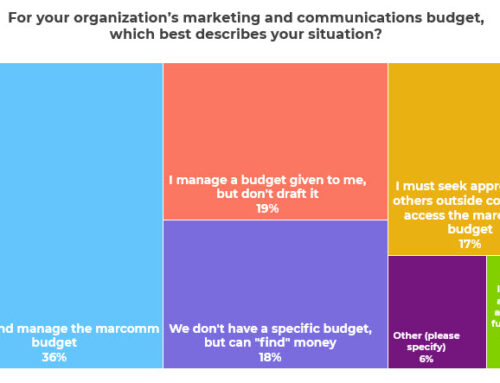The 2019 Nonprofit Communications Trends Report found that the most successful nonprofit communicators were putting significantly more emphasis on content marketing than less effective organizations.
For the most effective nonprofits, 24% consider content marketing an essential strategy, with only 5% saying it’s a low priority. That compares to a mere 11% of the less effective nonprofits who call content marketing essential, which is dwarfed by the 16% who say content marketing is a low priority. We also found a big gap in the mastery of content marketing skills in this year’s research between effective and less effective nonprofits.
Clearly, nonprofits have some work to do to embrace content marketing fully and to get the most out of this strategy.
Here are five content marketing strategy essentials to get you headed in the right direction.
Essential #1: Just Because You Make Content Doesn’t Mean You Are Doing Content Marketing
Here’s my definition of content marketing, which appears in my book, Content Marketing for Nonprofits:
Content marketing for nonprofits is creating and sharing relevant and valuable content that attracts, motivates, engages, and inspires your participants, supporters, and influencers to help you achieve your mission.
If that is too much jargon for you, focus on this: Valuable Content That Attracts. That is not all of the content you are creating!
Much of the content nonprofits create is pushed in front of people, rather than being used to pull them in. It’s much more valuable to you, the nonprofit, for that person to see the content than it is for them to read it. There’s nothing wrong with that kind of content — everyone produces it and hopefully produces it well — it’s just not content marketing.
Essential #2: Content Marketing Overlaps with Permission-Based Marketing, But They Are Not the Same Thing
Permission-based marketing is the number one marketing strategy for nonprofits. This is where people opt-in, subscribe or follow you; in other words, they give you permission to send them content.
While there’s overlap between permission-based marketing and content marketing, they are not the same thing.
You can send promotional content to your email list. You are doing permission-based marketing, but not content marketing in that case.
You write a super helpful blog post on your website, and Google gives it good SEO juice. You are content marketing, but not permission-based marketing in that case (because you didn’t send it to someone who opted in).
Of course, the sweet spot is when these two strategies overlap and, for example, you send that super helpful content to your email list, and the same content on your website encourages new site visitors to opt-in to the email list.
Essential #3: You Need Specific Content Marketing Goals and Objectives
Just like every other strategy you use, it needs a clear purpose. Content marketing can be used in many different ways, and it’s best if you can articulate those. That allows you to set goals and objectives for your strategy.
Here are just a few key ways that nonprofits can use content marketing:
- To build opt-in lists. People opt-in to get the valuable content and then you can communicate with them about others things too.
- For SEO (search engine optimization). Google and other search engines send traffic to your site, which raises awareness of your organization.
- To retain donors and other supporters. Great content helps keep people on your lists.
- To raise awareness. Great content can help people think or feel differently about an issue.
- To implement programs and services. If public education is part of your nonprofit’s mission, content marketing helps provide that education.
- For thought leadership. You can position your nonprofit as a leader especially when you are share cutting edge or opinionated content.
Essential #4: Good Content Marketing Requires a Strong Content Creation, Approval, and Publishing Process
To be successful at content marketing long-term, you need to build an efficient content generation machine. That means refining the whole content creation process, from start to finish. That process starts at the first glimmer of an idea and continues as the piece of content is researched, drafted, edited, reviewed, approved, published in multiple places, measured, and repurposed again later.
In most cases, more than a few people are involved in that process, which means you need conversations and decisions on who is responsible for what, honoring deadlines, managing editorial calendars, running helpful meetings, and much more. Mastering this process is a large part of the CALM not BUSY philosophy.
Essential #5: Content Marketing is Much Easier When You Organize Your Content Well
Content repurposing is essential to a good content marketing strategy. But that means you have to know what you have and where to find it so that you can use it again. Think about your assets like photography and videos. Also think about the types of content you create, like storytelling. How will you organize it?
How about other assets like logos and boilerplate? We recommend a marketing bank overall as well as more specific storybanking and photobanking.
Ready to more fully embrace content marketing at your nonprofit? Think hard about these five essentials.
Need more? I wrote a whole book called Content Marketing for Nonprofits: A Communications Map for Engaging Your Community, Becoming a Favorite Cause, and Raising More Money.





